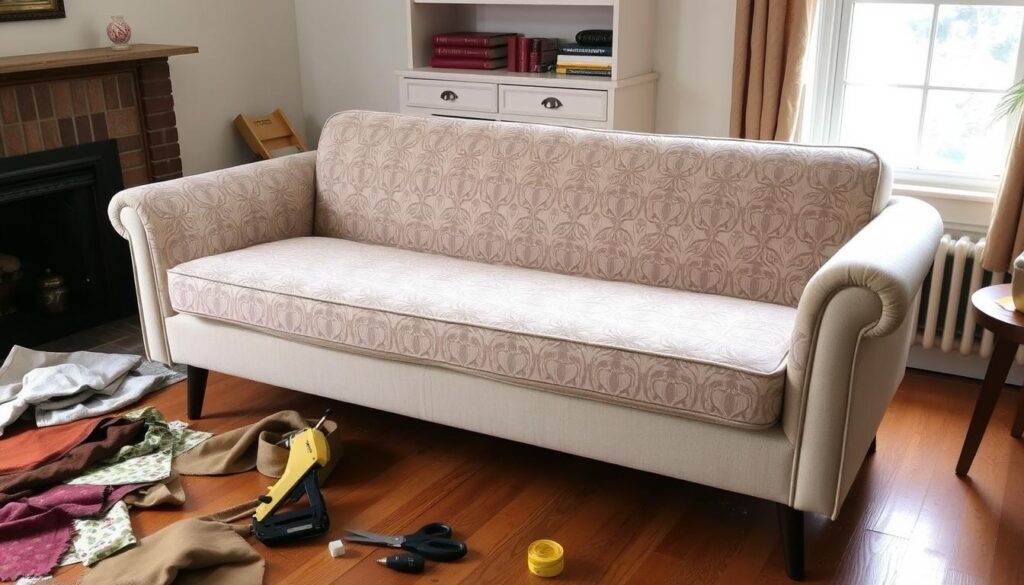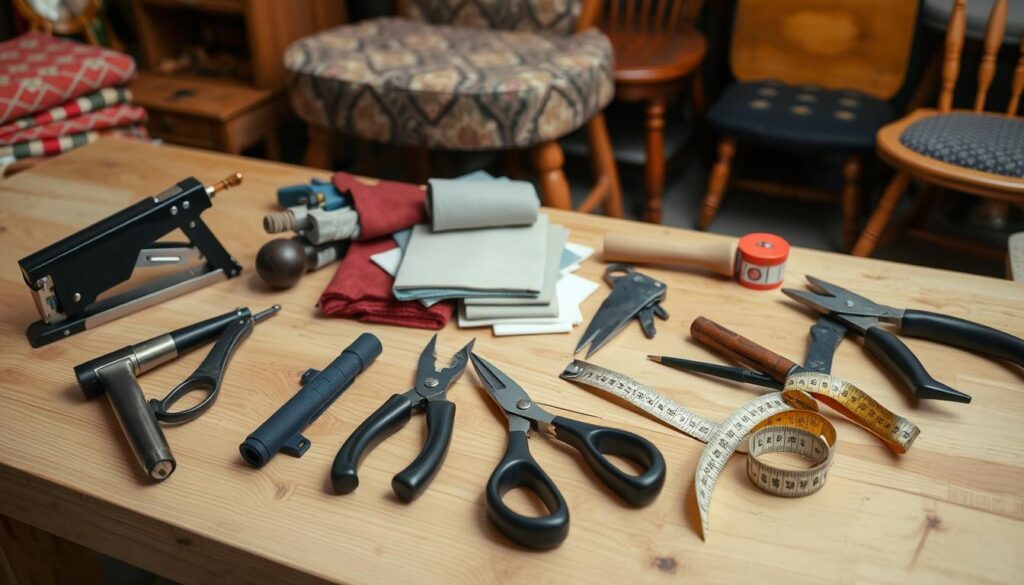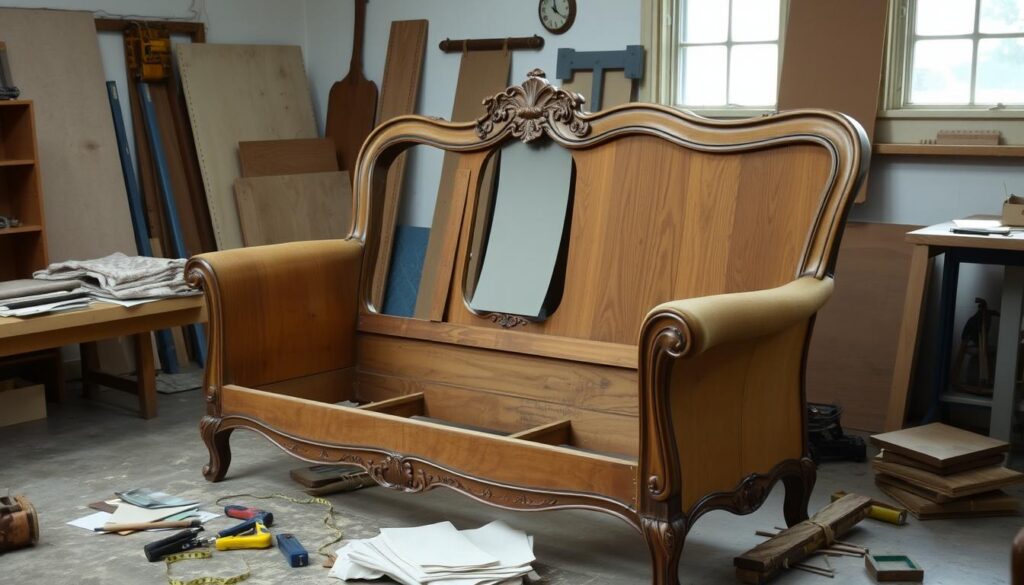Affiliate Disclosure
Sofa Insider Guy is a participant in the Amazon Services LLC Associates Program, an affiliate advertising program designed to provide a means for sites to earn advertising fees by advertising and linking to Amazon.
How Hard Is It To Reupholster A Sofa? Have you been looking at that old sofa in your living room, dreaming of a new look? Reupholstering a sofa might seem hard, but it’s actually a DIY project you can do. It can make your furniture look brand new. But, how hard is it really? Let’s find out more about this exciting makeover.

Key Takeaways
- Reupholstering a sofa is a time-consuming but rewarding DIY project.
- It requires attention to detail and some sewing skills, but is manageable for motivated intermediate DIYers.
- Careful fabric selection, tool preparation, and a step-by-step approach are key to success.
- Reupholstering can save you money compared to buying a new sofa, while giving your furniture a custom look.
- The cost and difficulty level of reupholstering depends on the size and condition of your sofa.
Table of Contents
Introduction: Giving New Life to Your Old Couch
Reupholstering your old couch is a smart, green choice. It lets you refresh your furniture without the cost of a new one. This way, you can make your living space look and feel new again.
The Benefits of Reupholstering
Reupholstering has many benefits that make it a wise choice. It’s good for the planet and your wallet. Here are some key points:
- Extending the Life of Your Furniture – New fabric can make your couch look and feel like new again. This means you don’t have to throw it away.
- Refreshing the Look and Style – It’s a chance to update your couch’s look. You can match it with your current style and trends.
- Avoiding Waste and Cost – It’s cheaper than buying a new couch. Plus, it’s better for the environment than throwing away old furniture.
- Promoting Sustainable Practices – Reupholstering is eco-friendly. It helps the circular economy by giving old furniture a new life.
When to Consider Reupholstering
Deciding to reupholster depends on your couch’s condition. If the frame is solid but the fabric is old or damaged, reupholstering is a great choice. It’s a way to make your couch look new again without buying a new one.
“Reupholstering is a fantastic way to give your old couch new life and align it with your current design preferences.”

Our Recommendation
Sleeper Sofa with Storage Chaise, Tufted L Shape Convertible Couch with 2 USB & Cup Holders, Dark Grey
Assessing the Condition of Your Sofa
Before starting a reupholstery project, it’s key to check your sofa’s condition. This step helps figure out if the sofa’s structure can handle new upholstery. Or if it needs more repairs or even a new one.
Begin by inspecting the old sofa and evaluating its condition. Look closely at the frame for any cracks, splits, or wear. Check the couch frame integrity and assess the sofa’s overall structure. Make sure the springs, cushions, and other parts are in good shape for new upholstery.
| Inspection Area | Evaluation Criteria | Recommended Action |
|---|---|---|
| Frame | Cracks, splits, or significant wear | Replace or reinforce the frame |
| Springs | Broken, sagging, or in poor condition | Replace the springs |
| Cushions | Worn, flattened, or in need of restuffing | Replace or restuff the cushions |
| Fabric | Heavily stained, torn, or irreparably damaged | Replace the entire fabric |
By carefully inspecting and assessing the condition of your sofa, you can decide if reupholstery is possible. Or if the sofa needs more repairs or a new one. This step ensures your reupholstery project is a success.
Choosing the Right Upholstery Fabric
Choosing the right fabric for your sofa is key. The fabric affects how long your furniture lasts and how it looks in your home. As you pick your upholstery fabric selection, think about a few important things to make the best choice.
Factors to Consider When Selecting Fabric
Durability is a big deal when picking fabrics for reupholstery. Sofas get a lot of use, so you need strong fabrics. Look for durable upholstery fabrics like linen, cotton, microfiber, and leather. They can handle spills and wear well.
Stain resistance is also key. Stain-resistant upholstery fabrics, like microfiber and treated cotton, make cleaning easy. They help keep your sofa looking new for a long time.
Popular Upholstery Fabric Options
There are many sofa fabric options to choose from. Each has its own benefits:
- Linen is a natural, durable, and breathable choice for upholstery fabric selection.
- Cotton is soft, comfy, and easy to clean. It’s also stain-resistant.
- Microfiber is synthetic, durable, and stain-resistant. It’s a favorite for upholstery.
- Leather is luxurious and durable. It adds a touch of class to your space.
- Velvet is plush and stain-resistant. It makes your home feel cozy and inviting.
The right fabric selection for your sofa should be both functional and stylish. By thinking about the factors in choosing fabric, you can turn an old couch into a beautiful piece that will last for years.
Gathering the Necessary Tools and Materials
Reupholstering a sofa is a fun DIY project. But, you need the right reupholstery tools and supplies for success. Before starting, make sure you have all the equipment for reupholstering. This will make the process easier and faster.
The key tools you’ll need to reupholster a sofa are:
- Staple remover
- Staple gun
- Needle-nose pliers
- Flathead screwdriver
- Fabric scissors
- Paintbrush
You’ll also need the right reupholstery supplies, like:
- Upholstery fabric
- Heavy-duty staples
- Sewing machine (optional)
- Sandpaper
- Fabric glue
- Furniture stain, sealant, or paint (if refinishing the frame)
Having all these items needed to reupholster a sofa ready before you start is key. Make sure you have everything you need. This way, you can easily turn your old sofa into a new one.


Our Recommendation
Oversized Sectional Sleeper Sofa with Chaise Lounge and Pull Out Bed, 7-Seater U-Shaped Sectional Couches with Cuddler for Living Room
Removing the Old Upholstery
Starting a sofa reupholstery project means first removing the old fabric. This guide will show you how to remove old sofa upholstery and take off the old couch fabric safely and efficiently.
Step-by-Step Guide to Stripping the Sofa
- Begin by finding the dust cover on the couch’s underside and gently pull it back.
- Then, remove the upholstery panel on the sofa’s back, noting where it goes.
- Use tools like a staple remover, screwdriver, and needle-nose pliers to remove staples.
- Remove fabric layers in the order they were put on, carefully to avoid damage.
- Keep detailed notes and photos as you strip the couch to make reassembly easier.
- Finally, throw away the old staples safely to prevent accidents.
By following these steps to remove old couch fabric, you’re on your way to giving your sofa a new look with fresh upholstery.
Preparing the Frame and Cushions
After removing the old upholstery, it’s time to work on the sofa frame and cushions. This step is key to making your couch look new again.
Refinishing the Frame
First, check the sofa frame. If the wood is okay, you can refinish it. Sand the frame, apply stain or paint, and seal it. This will keep the new upholstery clean.
Refinishing the frame can really improve your sofa’s look and feel.
Replacing or Restuffing Cushions
Now, look at the cushions. Decide if you need to replace the filling or just restuff them. Choose high-quality foam or use the old stuffing if it’s good.
Properly resizing and restuffing the cushions will make your sofa more comfortable and attractive.
| Task | Description |
|---|---|
| Refinish sofa frame | Sand, stain or paint, and seal the frame to create a fresh, polished look. |
| Replace couch cushion filling | Purchase new high-quality foam or batting to reupholster sofa cushions and restore plumpness. |
| Re-stuff sofa cushions | Carefully remove and reuse the existing cushion filling, adjusting the size and firmness as needed. |

By refinishing the sofa frame and replacing or restuffing the cushions, you can make your couch look and feel new again.
Cutting and Attaching the New Fabric
Now that you have your new upholstery fabric, it’s time to start the makeover. Cutting and attaching the new fabric are key steps in the reupholstering couch steps. Use the old pieces as patterns to cut the new fabric to the right sizes. Make sure to add extra fabric on the stapled edges for a tight, wrinkle-free fit.
Next, it’s time to attach the new fabric to the sofa frame. Start from the inside, pulling the fabric tight as you staple it. Attach the deck, inside arms, inside back, outside arms, and outside back in order. This ensures the new fabric is stretched and secured well, giving a professional upholstery fabric installation.
Take your time and focus on the fabric’s alignment and tension. With patience and detail, you can how to cut upholstery fabric and turn your old couch into a stunning piece that will wow your guests.
By following these steps, you’re on your way to a successful how to cut upholstery fabric and attach new fabric to sofa project. Remember, the secret to a professional look is to take the time to prepare and install the new fabric properly.
How Hard Is It To Reupholster A Sofa?
Reupholstering a sofa can be tough, especially if you’re new to it. The difficulty of DIY reupholstery depends on your skill level for sofa reupholstery and the reupholstering a couch complexity. If you’re good at DIY or sewing, you might do well. But, it’s best for those with more experience.
The reupholstering a couch complexity comes from the detailed steps. You need to remove the old fabric, get the frame and cushions ready, and put on the new upholstery. This is a slow and precise job that needs patience and focus. For beginners, it might seem too hard because it involves many skills and details.
But, with the right mindset and a bit of practice, even a beginner can do it well. The secret is to prepare well, learn a lot, and be determined to get better.
| Skill Level | Difficulty | Estimated Time |
|---|---|---|
| Beginner | High | 20-40 hours |
| Intermediate | Moderate | 10-20 hours |
| Advanced | Low | 5-10 hours |
The table shows how the difficulty of DIY reupholstery and the skill level for sofa reupholstery change with experience. An expert might find it easy, but a beginner will need a lot of time and effort.
Whether to do it yourself or get a pro depends on your skills, resources, and what you want. Think about the reupholstering a couch complexity and how hard it is to decide what’s best for you.

Our Recommendation
Loveseat Sleeper USB Port Pull Out Couch with Nailhead Trim, 3 in 1 Sofa Bed Adjustable Backrest with 2 Pillows, Grey
Finishing Touches and Decorative Elements
Once the new fabric is on, you can finish your sofa. You might add sofa trim and cording to hide staples and make it look neat. You can also make new throw pillow covers with any leftover sofa reupholstery details to match your sofa.
If your sofa has tufted cushions, think about getting a tufting kit. It can add decorative accents for reupholstered sofa like buttons and fancy stitching. Lastly, you can update the sofa legs by refinishing or repainting them.
Polishing the Reupholstered Sofa
Adding the last additional reupholstery finishing touches can really change your sofa. Here are some ideas to make it look better:
- Apply decorative cording or trim to cover stapled edges
- Sew new throw pillow covers using leftover fabric
- Install tufting buttons and stitching for a classic look
- Refinish or repaint the sofa legs for a cohesive finish
“The devil is in the details when it comes to giving your sofa a fresh, polished look after reupholstering.”
By adding these decorative accents for reupholstered sofa, you can turn an old couch into a beautiful piece that shows off your style.
Costs of DIY vs. Professional Reupholstering
When you think about reupholstering your sofa, you have two main choices. You can do it yourself or hire a professional. The cost of each option is a big part of your decision.
Doing it yourself can save you money. The cost depends on your sofa’s size, the fabric quality, and any extra materials or tools. Fabric prices usually range from $50 to $70 per yard.
| Factor | DIY Reupholstery | Professional Reupholstery |
|---|---|---|
| Cost | $100 – $1,000 | $600 – $4,000 |
| Skill Level | Requires some DIY experience | Handled by skilled professionals |
| Time Commitment | Significant time investment | Quicker turnaround |
| Upholstery Fabric | $50 – $70 per yard | Varies based on fabric quality |
But, if your sofa needs a lot of repairs or has complex details, professional help might be worth it. Experts can tackle tough projects and ensure a top-notch finish. Professional costs usually fall between $600 to $4,000, based on the sofa size and project complexity.
Think about your skills, sofa condition, and budget when choosing between DIY and professional reupholstery. If you’re good with DIY and have the right tools, doing it yourself can save money. But, if your sofa needs a lot of work or you want a professional look, hiring an expert might be the better choice.

Our Recommendation
Multifunctional Loveseat Sofa, Easily Converts from Sofa Couch to Sofa Bed, Comfortable Thick Seat Cushion, Suitable for Both Living Rooms and Apartments, Beige
Conclusion
Reupholstering a sofa is a fun DIY project. It lets you give an old piece of furniture a new look and make it your own. This process might take time and need careful attention, but it’s worth it.
You can make your sofa last longer, save money, and help the environment. By choosing the right upholstery fabric and following the right steps, you can make a sofa that’s both beautiful and comfy. It will be the heart of your living room for many years.
Whether you do it yourself or get a pro, reupholstering your sofa is a smart move. It’s a way to breathe new life into old furniture and make your home reflect your style. With the tips from this article, you’re ready to turn your old sofa into a stunning piece of furniture.
FAQ
What are the benefits of reupholstering a sofa?
Reupholstering a sofa can make your furniture last longer. It also gives your space a fresh look without the high cost of a new couch.
When should I consider reupholstering my sofa?
Think about reupholstering if your sofa’s frame is still solid. But, if the fabric is worn, stained, or outdated, it’s time for a change.
What factors should I consider when selecting upholstery fabric?
Look at the fabric’s durability, stain resistance, and ease of cleaning. Choose thicker fabrics like linen, cotton, microfiber, or leather for a sofa that gets a lot of use.
What tools and materials do I need for a reupholstery project?
You’ll need a staple remover, staple gun, and needle-nose pliers. Also, fabric scissors, a paintbrush, and upholstery fabric are essential. Don’t forget staples, and maybe a sewing machine, sandpaper, fabric glue, stain, sealant, or paint.
How do I remove the old upholstery fabric?
Start by removing the dust cover on the couch underside. Then, take off the upholstery panel on the back. Use a staple remover, screwdriver, and needle-nose pliers to remove each staple, working from the inside out.
How do I prepare the frame and cushions for the new fabric?
First, sand the frame, apply stain or paint, and seal it. Next, check the cushions. Decide if you need to replace or restuff the filling.
How do I attach the new upholstery fabric?
Cut the new fabric to the right sizes using the old pieces as patterns. Attach the fabric to the sofa frame, starting from the inside. Pull the fabric tight as you staple it in place.
How difficult is it to reupholster a sofa?
Reupholstering a sofa is a tough task, especially for beginners. It needs patience, detail, and the right tools. If you’re an advanced DIYer or a motivated sewer, you might succeed. But, it’s best for those with more experience.
What are some finishing touches I can add to my reupholstered sofa?
Add decorative cord or trim to hide staples. Sew new throw pillow covers from leftover fabric. You can also add buttons and decorative stitching to tufted cushions. Refinish or repaint the sofa legs for a complete look.
How much does it cost to reupholster a sofa myself compared to hiring a professional?
DIY reupholstery can save you money, as it’s cheaper than hiring a pro. The cost depends on your sofa’s size, the fabric quality, and any extra materials or tools you need.

